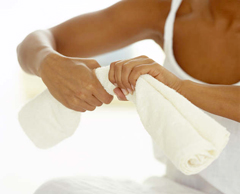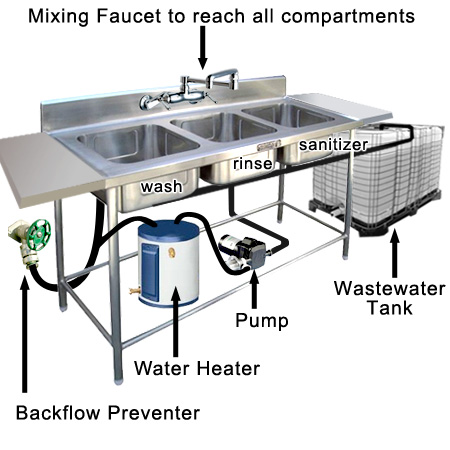Temporary Food Facilities Training - Risk Factor 4 - Sanitize
Addressing CDC Risk Factor Number 4: Contaminated Food Or Equipment / Cleaning and Sanitizing
Cleaning Cloths
Food contact surfaces such as cutting boards and slicers must be sanitized between each use. Cleaning cloths and a sanitizer solution must be used and kept inside the booth.
To maintain the cleaning cloth in working condition, you must do the following:
- Store in a bucket with sanitizing solution when not in use.
- Use for one purpose only unless washed and sanitized.
- Replace the sanitizing solution when it becomes cloudy.
Utensil Washing
Utensils and cutting boards must be properly washed, rinsed, and sanitized using a three-compartment sink either located within the booth or shared by up to 4 booths handling open food when provided by the event organizer.
The 3-compartment sink may be placed outside the booth but shall have overhead protection. The sinks shall be large enough to accommodate the largest utensil.
The 3-compartment sink must have two drainboards. The first drain board is to be used for soiled utensils. The second drain board is to be used for air-drying clean, sanitized utensils.
- The first sink compartment shall be labeled “wash” and hold hot, soapy water.
- The second sink compartment shall be labeled “rinse” and hold clear, warm rinse water.
- The third sink compartment shall be labeled “sanitizer” and hold 100 ppm of chlorine (submerge utensils in the sanitizer for 30 seconds) or 200 ppm of “Quat” (Submerge utensils in the sanitizer for 60 seconds).
Physical And Chemical Contamination
Physical hazards include dirt, hair, broken glass, shell or bones, and other objects.
The following are food safety controls:
- Clean can openers before and after each use.
- Do not use glass to scoop ice (use food-grade scoops).
- Do not chill glasses or food items in the ice that will be used for drinks.
- Maintain nonfood items separate from food and food-related surfaces.
- Do not store toothpicks or non-edible garnishes on shelves above food storage or preparation areas.
Chemical hazards include:
- detergents
- cleaning and sanitizing agents and other similar chemicals.
Keep them labeled and away from food and food-related surfaces.
The following are food safety controls:
- Carefully measure chemicals.
- Follow label directions for storing and using chemicals.
- Store chemicals in their original containers. Keep them separate from and below food or food-related surface areas.
- Never use food containers to store chemicals or chemical containers to store food. Empty chemical containers must be properly discarded.



